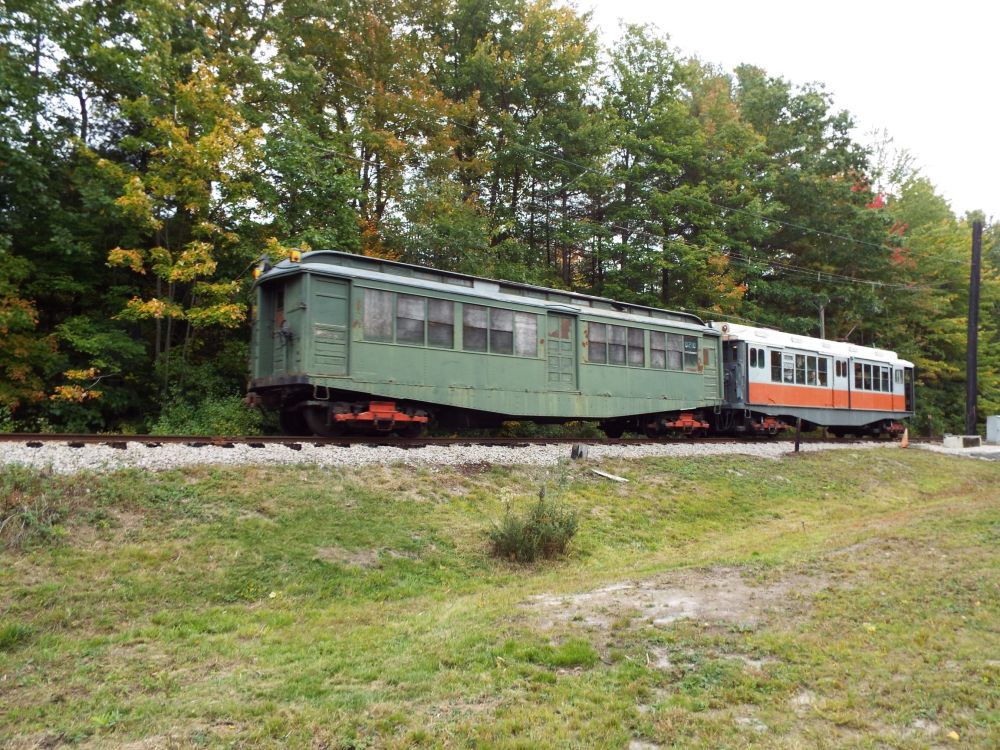
- Builder
- Pressed Steel Car Co.
- Description
- Elevated car
- Secondary Use
- Railway maintenance
- Type
- Rapid Transit Cars
- Year
- 1906
- Retired from Service
- 1994
- Acquired by the Museum
- 1994
- Fund
- 553
- Sponsor/Manager
- None
Metropolitan Transit Authority 0210
From Boston, Massachusetts
History
The nation’s first subway, Boston’s Tremont Street subway, opened in 1897 and operated with surface streetcars. Boston did not open its first elevated line until 1901. Boston Elevated Railway’s Main Line Elevated (approximating the route of today’s Orange Line of the MBTA) opened in 1901 along with the Atlantic Avenue Elevated later in 1901. The Main Line initially used the Tremont Street subway through downtown Boston and elevated structures outside of downtown. The Main Line opened with an initial fleet of 100 wooden railroad roof open platform gate cars that had manually operated center doors, with 50 more cars being added in 1903. The railway added another 24 wooden cars of a different design with closed ends – labeled as number 2 cars – in 1904. All of Boston’s wooden elevated fleet were retired and scrapped by the late 1920s, so none survive.
The year 1904 was also the year that saw the introduction of the first all-steel passenger cars with the opening of the New York City subway. One of these initial New York all-steel cars, Interborough Rapid Transit No. 3352, is now in the Seashore collection. Both because of upcoming elevated service expansion and the fact that the steel cars were safer than wooden cars in tunnels, though Boston had not suffered any underground disasters, BERy ordered its own first set of steel cars from the Pressed Steel Car Company of Pittsburgh, PA. These were number 3 cars (Nos. 0175 – 0219) which arrived in 1906. (In Boston, rapid transit car numbers all started with zero to distinguish them from surface streetcars.) Comparing Boston’s new steel cars with those of New York, although both of the car series shared a canvas on wood roof design, Boston’s steel design was different from that of the New York cars in that Pressed Steel relied on a very strong below floor frame with a lightly built passenger compartment above it compared to the IRT design of the entire sides, from bottom sill to window sill, acting as girders that bore the weight. Boston’s cars were also more modernly equipped, both with pneumatically operated doors and a fully automatic motor control. For over two decades the number 3s operated from Everett to Forest Hills on both the Atlantic Avenue Elevated and the Main Line Elevated.
BERy acquired more steel elevated cars in four additional series between 1911 and 1917, bringing the roster to 170 wood cars and 157 steel cars. Replacement of the wood cars finally started in 1921 when 65 No. 8 cars were added, and about 50 wooden cars retired. Finally in 1928, 100 Nos. 9 and 10 cars were added and the remaining wood cars retired.
The oldest steel cars didn’t last much longer, as ridership losses reduced the car requirements. The No. 3 and 4 cars were all in storage by 1933, and by May 1, 1935, the No. 5 cars had joined them. With the Atlantic Avenue Elevated closed, the No. 3 cars were surplus, and all but two of the cars were scrapped in 1939. BERy converted the remaining two cars, Nos. 0192 and 0210 to wrecking tool cars. This conversion included removing all the seats. No. 0210 operated along with crane car No. 0504 (which Seashore acquired in 1981). It is not clear when No. 0192 was retired, but No. 0210 soldiered on, outliving the elevated structure itself. Because No. 0210 had a wood roof, it rated indoor storage at Sullivan, Forest Hills and later Wellington carhouses. No. 0210 survived corporate reorganizations as the Metropolitan Transit Authority in 1947 and the Massachusetts Bay Transportation Authority in 1964. In 1971, the MBTA painted the car in its yellow work equipment paint scheme. The MBTA used No. 0210 less after 1975. No. 0210 was the last railroad roof rapid transit car to survive in Boston. The MBTA briefly considered keeping No. 0210 as part of possible historic vehicle collection but decided to offer it to Seashore in 1994.
Seashore acquired No. 0210 from the MBTA for $1. Seashore could operate No. 0210 in a train with BERy class 10 elevated cars Nos. 0997 and 01000 which had come to the museum in 1981 and 1980. Seashore intended to use these Boston elevated cars in conjunction with the former Northampton Station which Seashore brought from Boston in 1989. Indoor storage while at Boston contributed to the overall preservation of No. 0210 which remained in quite good condition at Seashore. In 1997, Seashore repainted No. 0210 to the dark green paint scheme the car had when in BERy passenger service. The interior, however, remains without seats. No. 0210 is the oldest surviving Boston elevated car. No. 0210 is the only car in the collection that shows the character of the original Boston Elevated Railway fleet, is the closest contemporary of the Boston’s Tower C and Northampton Station, and remains one of the oldest all-steel passenger railway cars in the world.
Technical Information
- Seats: 44
- Control: M (C-26-C)
- Brakes: AMLE
- Compressor: CP-28
Trucks
- Number: 2
- Manufacturer: Standard
- Model: C-60
Motor
- Number: 2
- Manufacturer: Westinghouse
- Model: 301D
Weight and Dimensions
- Length: 46’ 7.00"
- Width: 8’ 8.00"
- Height: 12’ 4.00"
- Weight: 67602 lbs.
Additional Images

Kenyon F. Karl on 10/08/16
© 1998 - 2025 New England Electric Railway Historical Society. All Rights Reserved.